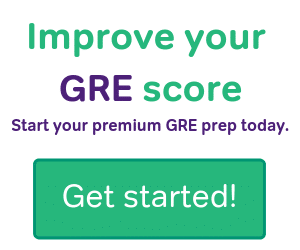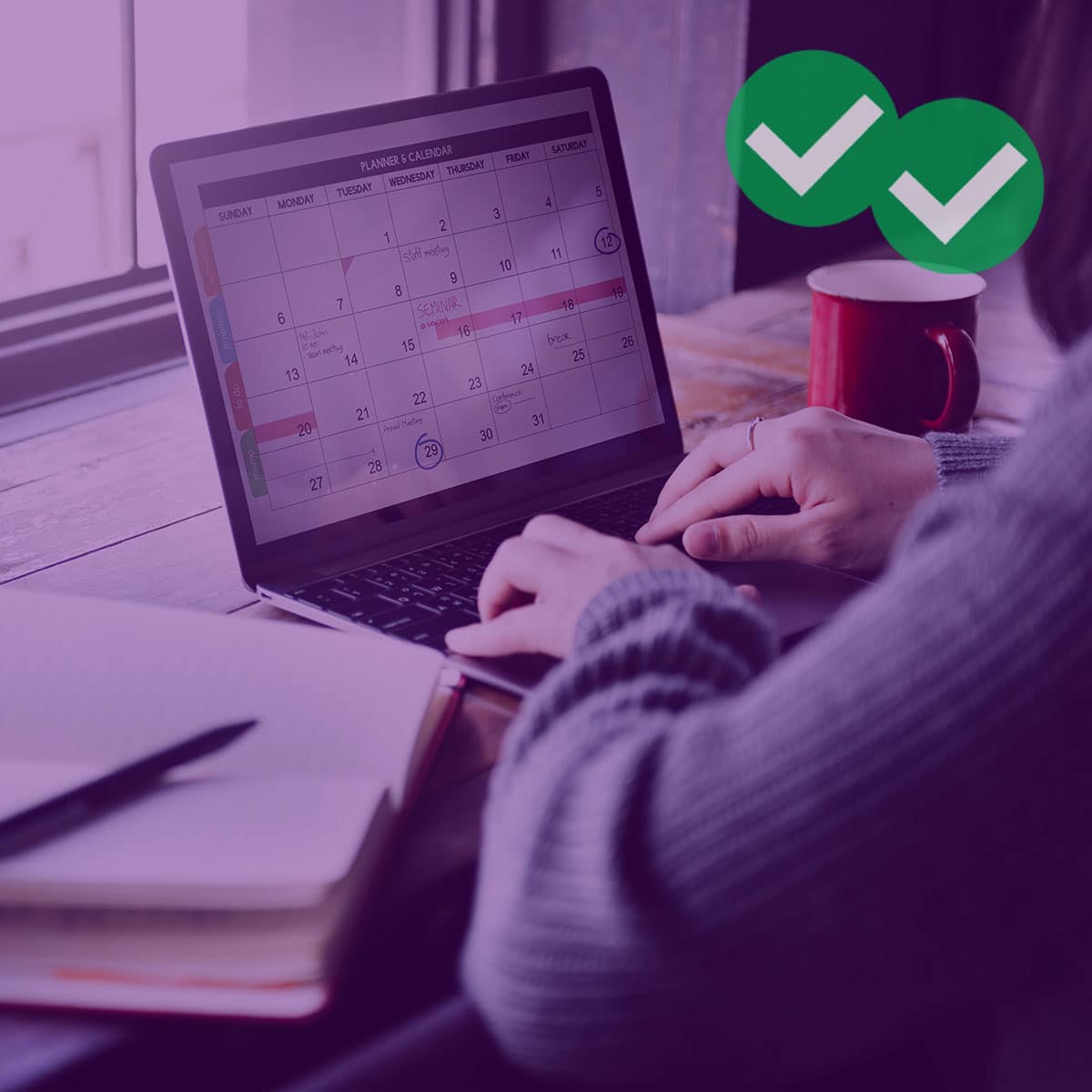The content in this post applies in 2024 to the new, shorter GRE!
Just a quick note to start: This is a monthly GRE study schedule—if you’d prefer a more detailed schedule with week-by-week instructions, check out one of these other 6 month study guides instead:

Do you need to adapt this study schedule to meet your needs? Check out this blog post for adjustment tips!
Now, to work this study guide, I am going to come up with a hypothetical student named Charlie. For some, Charlie’s background and predicament will resonate on several, if not many, levels.
Charlie has been out of school for a couple of years, and is now hoping to get into a competitive program for a Master in economics. Because he took mostly math and science courses in college, Charlie has not had much opportunity to develop his vocabulary and critical reading skills.
Currently, he is weak in vocabulary, as he took mostly math and science classes in college. He rarely reads outside of class. Indeed, if he doesn’t get a headache from critical reading, it just makes him fall asleep.
That doesn’t mean his math skills are where they need to be. After all, the GRE math tests fundamentals most students haven’t seen since early high school. Charlie hasn’t found the area of any shape in almost a decade, feels stymied by the rules of exponents, and believes, erroneously, that 1 is a prime number.
Charlie takes a test: his verbal ends up in the upper 130’s, and his quant score is below 150. If Charlie wants to have even a slim chance of getting into his program, he will need to increase both his math and verbal scores by at least 10 points.
Clearly, Charlie needs a comprehensive, aggressive, and, above all, efficacious study plan. Charlie needs the 6-month GRE study guide.
Essential Materials:
- Magoosh GRE Prep (Includes lesson videos, practice quizzes, mock tests, score predictor)
- Easy magazines: Time, Scientific American (start low…but not too low; these magazines are still filled with vocabulary and relatively challenging prose)
- Difficult magazines: Atlantic Monthly, The New Yorker, The Economist
- wordnik.com, dictionary.com (for definitions and, more importantly, example sentences
- ETS’s PowerPrep Online
(If you would prefer to take the practice test on paper, you can print out ETS’s practice test PDF (with video explanations here). Take note that PowerPrep Online and the paper-based test have overlapping material, so it won’t be of much help to do both, unless you space them out far enough so that you won’t recognize the questions and answers! I recommend using PowerPrep Online if you can, since taking the test on a computer is a better simulation of exam day conditions.) - Magoosh’s online GRE Flashcards. They’re free and you can use them on the web, on your iPhone/iPad or Android!
- Your own flashcards made on (Quizlet.com, Word Dynamo (dictionary.com))
- ETS’s 2nd. Edition Official Guide to the GRE book
Supplemental/Optional Materials:
- GRE Prep App for iPhone and Android (Magoosh’s free app contains lesson videos, practice questions, and additional resources that you can access on your phone)
- GMAT Official Guide
- Manhattan GRE Guides (8 guides total; you can choose just the ones in the areas in which you struggle)
- Manhattan’s 6 GRE online practice tests (one test is offered for free, with five additional tests available for purchase)
- LSAT practice tests (for verbal scorers in the top 10%)
- Old ETS GRE Book (AKA Big Book)
- Barron’s New GRE Guide
- Magoosh’s GRE Complete Guide
This comprehensive, web-based guide to the GRE gives you the quick but very helpful overview you need to understand this test. You’ll see how the GRE is designed and scored, what skills it tests, how to find and use the best GRE prep, and how to study for each test section. - A guide to GRE Practice Test Resources
This page includes instructions on where to find good full-length GRE practice tests, and how to take practice tests and incorporate them into your studies. This page also has links to Magoosh’s free GRE diagnostic quizzes.
A note about additional materials:
Magoosh contains all the information you need for wild success on the exam and many students have achieved spectacular results using nothing but Magoosh. Nevertheless, this plan recommends that you buy additional materials and use them, in addition to the Magoosh materials. Here’s why: These plans were structured with far-reaching pedagogical principles in mind, and a deep consideration for how the human brain learns. Most people cannot hear or read something just once and, from that single hearing, remember it completely and understand it fully.
At Magoosh, we are very ambitious for our students; we want them to learn as thoroughly and as masterfully as possible. We recommend using these additional resources to provide additional practice, alternative explanations, and extra review. Not every student will need or want additional materials, but for those who do, the books we recommend are the best for the overall goal of doing very well on the exam.
Month 1:
- Strengthen reading ability and vocabulary recognition
- Nail math fundamentals and become adept with numbers
Weeks 1-2
Each week Charlie reads articles from Time and Newsweek. Indeed, he tries to finish every article that doesn’t relate to Justin Bieber’s new haircut, or the latest electronic gadgets. After each issue, he writes half-page summaries for three articles from each magazine. These summaries strive to incorporate vocabulary and varied sentence structure. The latter will especially help with the Analytical Writing Assessment (AWA).
Charlie has also checked out Magoosh’s GRE flashcards. He works through about 10 words a day, making sure to use the words he is learning as often as possible.
Weeks 3-4
Charlie picks up the old ETS GRE guide and begins doing Sentence Completions from this book. He, of course, has watched the Magoosh Text Completion Modules. For each word he doesn’t know, he enters them down in Word Dynamo/Quizlet.
Charlie watches all of the math video lessons from Magoosh. He practices using McGraw-Hill Conquering the GRE Math. He also becomes comfortable manipulating percentages and fractions. By the end of the month, he is practicing with Magoosh easy math problems.
Month 2:
- Challenge reading abilities even further
- Move out of comfort zone in math and start tackling harder problems
- Finish watching all the Magoosh lesson videos (make sure to do practice quizzes after each lesson type)
- Strengthen weak areas, such as Data Interpretation in math or Paragraph Arguments for verbal
Something has happened to Charlie’s brain. He no longer falls asleep as soon as he starts reading an article. A part of his mind is already anticipating how he is going to craft a summary around whichever article he happens to be reading. Now, he is ready for the Atlantic Monthly and The New Yorker. He is also ready to start practicing some GRE questions.
Charlie finishes watching all the verbal module videos, and works his way through the easy and medium level questions. He also finishes the first three tests in there (he ignores the analogy section).
Finally, for vocab, his tally is up to 500 words in two months. The words are also starting to stick in his brain a lot more. And, with his diet of three magazines a week, he is constantly seeing words that are part of his 500 words.
Charlie feels he is getting the math fundamentals. He shouldn’t become complacent, however, but instead attempt to do problems that are at the medium level in Magoosh. In the Official Guide to the revised GRE Book he works through the “Medium” set of math questions at the begininning of the book. After completing these problems he watches the video explanations to make sure he understands everything.
Month 3
- Work on actual New GRE material
- Focus on areas of weakness (Use Magoosh.com or Manhattan GRE books)
- Learn from mistakes
- Seek out more challenging reading
- Track progress using Magoosh’s score predictor
- Watch Magoosh AWA video
Charlie is finally able to take a full mock exam on Magoosh. He checks his answers, and goes over his mistakes. For both Math and Verbal, he tries to complete all the hard questions on Magoosh. He finishes the remaining tests from the old Big Book.
Charlie has also bought the Reading Comprehension guide from Manhattan GRE. He is struggling with reading comp so knows that both the extra practice, and the useful tips and strategies, will help him turn this weakness into a strength. He also purchases a math volume from Manhattan GRE to help him in the area in which he struggles most.
For outside the prep-o-sphere reading, Charlie also adds The Economist to his reading schedule, and has dropped Newsweek and Time.
While not part of the overall score, the AWA still counts for something, and Charlie wants to score in at least the top 50%. He watches the Magoosh AWA video and begins a 5 minute brainstorming session with a variety of different prompts.
Month 4
- Branch out with ever more challenging content in both math and verbal
- Continue to use Magoosh score predictor, identifying weak areas
- Do timed questions
He buys a copy of the GMAT OG. He works through all of the Problem Solving Questions in Math. He also finishes all of the Reading Comprehension questions, and half of the critical reading questions. For extra practice, he buys Barron’s New GRE Guide and completes all the questions from there. This mostly helps with his vocabulary, but also gives him reading comprehension practice.
Now Charlie breezes through magazines. He is able to identify words, and see how they are used in context. He can also make word maps in his head, grouping as many as ten synonyms for certain words. He has now learned over 1,000 words, many of which pop up in his summaries (the AWA will now be a lot easier, too).
He has also taken 2 Manhattan GRE tests – both to gauge his progress and prepare him for the PowerPrep test he will take in month 5. Charlie also sedulously (a good GRE word!) reviews the questions he missed or answered correctly, but was still unsure.
Charlie also writes a full-length essay as part of his practice test.
Month 5
- Figure out score based on PowerPrep
- Do timed practice sets from
- Use the practice questions in the 2nd. edition Official Guide to determine areas/concepts in which you struggle
- Work through practice questions from the essential and secondary sources mentioned at the beginning of this post (should be aiming to complete between 75-100 quant questions and 75-100 verbal questions a week. Don’t just answer questions but sedulously review mistakes).
For Math, Charlie has now worked his way through the OG book and most of Magoosh’s problems.
For Verbal, he finishes all the problems in Barron’s, and the rest of the pertinent questions in the GMAT OG.
Charlie takes all sections of the PowerPrep to make sure he understands the problems. He also does his best to understand why the wrong answers are wrong, not just why the right answers are right.
Charlie uses the Magoosh customized tests to work on his weaknesses. He also takes the 3rd Manhattan GRE test and does one mock test from Magoosh.
Month 6
- Take timed sections constantly, customized the problem types that give you the most difficulty
- Do mock tests to better improve your test taking ability
- Reviews copious list of vocabulary words, focusing on word usage (using wordnik and dictionary.com)
Charlie focuses on The Official Guide to the New GRE. He works his way through all the problem sets in the beginning. Two weeks before his test date, he takes the test at the back of the book.
One week before the test, he takes the sections from the online test one more time (just to make sure he really understands the material). He finishes the Manhattan GRE tests, practices old problems – both verbal and math – from the Old GRE Guide, and makes sure he knows all of the vocabulary that comes up in both texts.
For Math, he practices with Magoosh questions (even those he has already done), creating timed practice sessions a couple of weeks before the test. After reading so many articles, his in-context vocabulary his excellent, his writing has improved markedly, and he is now able to choose many pertinent examples for whatever AWA question the test throw at him.
After the Exam:
Months later, when Charlie is admitted to the program, he is undaunted by all the reading he had to do, and unequally undaunted by all the twisted syntax the texts throw at him. He is also much faster at calculating restaurant tabs, doing discounts in his head, and figuring out how long it will take him to drive a certain distance at a fixed speed (though he has yet to employ the area of a triangle formula).
As for you, the user of the 6-month study guide, focus on those areas in which you differ from Charlie. No two individuals are the same, but keep Charlie’s general approach in mind: study from a variety of quality sources, constantly read from periodicals, refresh your vocabulary while you enlarge it, focusing on word usage, and return to material you’ve done before to make sure you understand it. Doing so helped Charlie, and I’m sure it will help you.






Comments
30 responses to “6 Month GRE Study Guide”
hi chris
I am non native student.
I have 5 month to prepare GRE. I am worry about verbal section and have strength base in math part.
please guide me about how to prepare for GRE with consideration of non native student features.
best wishes
Hi Farshid,
Our study plans apply regardless of whether one is a non-native speaker or not. One area you can perhaps spend more time than the study guides mention is on vocabulary. Barron’s 1100 Words You Don’t Know is particularly helpful for non-native speakers, as it includes lower-level words.
Otherwise, go ahead and follow the study guides. Many non-native speakers have followed the “Magoosh way” and done well :).
Update!: Check out Magoosh’s free online GRE Flashcards instead of Barron’s. They’re designed to help you remember even the toughest vocabulary, hand picked by me, and of course, they’re free!
Hi Chris,
I really like the 6-month study plan you’ve outlined and have completed week one of reading Time and Newsweek articles. One question – when I finish the issues sometimes I have a really difficult time writing the summary and others not as much. I’ve been out of school for awhile and wanted to ask if you have any other tips on how to improve reading comprehension?
Thanks!
Sally
Hi Sally,
The summaries can be great, but can also be tedious – so I congratulate you on your tenacity :). The biggest downside is you do not have a teacher or tutor to give you feedback and make sure you are actually understanding the contents. But persevere – as long as you feel that a friend could read your summary and have a solid grasp of the article, then you are doing a good job.
I would continue with the plan seeking out ever more difficult reading resources (New Yorker, etc). Ultimately to improve at reading comp. you will have to do passages from GRE. The good news is this prep plan will have you reading with more confidence and ease.
Hope that helps 🙂
Hey chris,
I just had a question – I read your gre prep stuff and the 6 month study plan, and I am more worried about verbal than anything else; what would you suggest? Also, for math I am aiming for a perfect score. I’m usually good at math – usually get A’s and somestimes B in math courses in college. Any suggestions?
Hi Sonita,
For a more step-by-step 6-month program check out this other post from Magoosh – I think it should definitely answer all your questions:
https://magoosh.com/gmat/2012/6-month-gmat-study-schedule/
My quick take: the best question bank for those looking to score high on the Quant is Magoosh. Nova is good but it only has a book for the old GRE, so you don’t get the new question types.
For Verbal, magoosh is great. Just check out our testimonials:
http://gre.magoosh.com/testimonials
Hope that helps :).
Oh my word, Chris! I am sooo weak in math. I lived at our learning center at the University and barely squeaked by with a “B” in STAT’s. Should I get a math tutor to help or just follow the 6-month study plan?
Carla,
A great math tutor can do wonders. On test prep esp. there are a lot of “tricks” that a tutor can help you pick up on quickly. Of course that tutor – working together with you on the 6-month plan – will help you with any initial hiccups in fundamentals. That way, once you’ll be able to work on your own, you can do so with more confidence.
Hope that helps!
Hi:
I just took a practice test and I got a terrible score. I got 500 on the verbal section and 400 on math. I honestly do not even know where to start studying. I always hated math and I was never good at it and to make matters worse English is not my first language. Is there is hope for me? What is the best way to study for the English section and math section at the same time? How do I learn all those new vocabulary words? Is there is a study strategy for non-native English speakers? How many hours a day should I study? Which books should I buy? and in which order should I use them? I’m currently not working and I already graduated from college. So, I could definitely spend lots of time studying.
One more question should I study math and English on the same day? or should I alternate?
Hi Paola,
Those are all great questions!
The bottom-line: the GRE is not impossible for non-natives.
Indeed your scores aren’t as bad as you think. Many native speakers I’ve tutored have started out at a lower score – and have gone on to 1300+ (old scale).
For the math section, I can’t recommend Magoosh enough (I know – I work for them. But really, our math lesson videos are fantastic, esp. if you feel you never really had a solid grasp of the basics).
For the verbal section, things may be a little tougher – at first. I think these posts should help you get started.
https://magoosh.com/gre/gre-vocabulary/
https://magoosh.com/gre/2011/reading-vocabulary-in-context-where-should-i-start/
Let me know if you have any other questions – I’d be happy to help!
Hi Chris,
I want to begin studying for the GRE, but I do not know where to start. I am trying to achieve an considerably high on both parts. My weakness is definitely in the verbal section. But I haven’t seen math in a long time so I will need to spend a significant amount of time studying for both the verbal and quantitative sections of the exam. I plan to study anywhere from 6 months to a year for the test. Can you please advise on what material to purchase to study for this exam?
Hi Shakeshia,
Well, you’ve definitely come to the right place. Read the post above – all the suggested texts as well as how to employ them is covered. Afterwards, let me know if you have any specific questions.
I’d be happy to help!
Hey Chris, I am currently starting the process of studying for the GRE and would like some recommendations as to what gre prep books are helpful. I am buying the ets official guide, was debating about Barron’s New Gre and their flashcards as well. Would you recommend any other study material? I know you have said the Manhattan Gre series is great, however, it is unavailable on amazon and rather expensive. Thank you for you help!
Hi Eulalia,
Hmmm…you can actually buy the books directly from the Manhattan GRE site. They are expensive, so I would recommend buying just one or two of the eight volumes, probably in the area that you need the most help with. The best part is you only need to buy one guide to get access to their 6 on-line tests.
Otherwise, Barron’s is pretty decent. Coupled with the Official material that may be enough, depending on your target score and your baseline (where you are starting from).
Hope that helps!
hi Chris,
Could you please suggest some books for vocab. I was planning to buy kaplan,but after going through your reviews I’m skeptical about getting one. I already have the ets book, so in addition to that should barron’s and princeton be sufficient?.
nice strategy/study plan
Thanks a ton 🙂
Hi Anu,
I’m wary of Kaplan mainly because of their reliance on word roots and their even more questionable word groupings.
Princetone REview Word Smart is much better. There is a general book, one for the GRE, and a second book general one. The general book is a great place to start. Follow that up with the GRE specific one and you should be in a good spot.
Barron’s 3500 word list is not good because it offers vague definitions and mediocre example sentences.
Hope that helps!
Thank you chris!
For vocab, Princeton Review Word Smart is fine. I would not recommend Barron’s for vocab. Though it may contain every word you will see test day, the definitions are in some cases vague. This is especially concerning because the Revised GRE requires you to recognize vocab in context. A massive vocab list provides no context. Basically, you think you will know a word, but in many cases you won’t.
That’s why I recommend PR Word Smart. It at least provides a few sentences for each word, sentences which are generalyl well-written and engaging.
hey,
Thank you Chris for your valued guidance. I have another question: is it advisable to refer to PR for verbal, and follow it up with magoosh for practice?
I really like PR for its verbal strategies. It makes the test seem approachable to the point of fun – which is actually a problem. So sure, start off with PR, but know that the GRE cannot be “cracked” but requires hard work. Magoosh should do the trick in terms of tough content.
Hope that helps!
Hey Chris,
Sorry for another question, but are there any other books in the market for math except ETS and Kaplan, which will be useful ?
Thanks, Pri
Hi Pri,
Sure, I would highly recommend the Manhattan GRE series.
Hi Chris,
I have always been average at math and therefore, started with Kaplan’s Math Workbook, because it goes to explain each section followed by corresponding exercises. While doing this, I feel comfortable with the math and it seems to be not as hard as I expected. I tend to do 1.5 -2 exercises daily, coupled with a review every weekend. I wanted to ask,
if this is the right way to go about it?
and are the practice questions, easier or harder than on actual test?
what other math practice books do you suggest?
Also, I am not doing the official ETS book yet, because I want to review first and then tackle the official problems.
Hi Pri,
Actually, I would not recommend your method. Even for math, you should always use a variety of the material. Kaplan is but one – and a mediocre one at that. The questions on the test – as well as the range of concepts – will be more difficult.
In this post, I reference a number of different sources – including the ETS book. Magoosh is another – our questions are even harder than those on ETS.
Hope that helps!
Thanks for the speedy (and helpful) reply, Chris!
I’m an artsy through and through, and maths has never been my forte (more like my mortal nemesis!). I brushed up on some basics and took the paper-based exam, and I got a raw score of 33 (72nd percentile). Not sure what to make of it – given that I was expecting to score in the 50th percentile in math, I can’t help but think the prediction is overinflated, or that the questions were much too easy. I scored 750-800 in the verbal section, so I don’t plan to spend too much time on it.
Would you recommend anything in particular?
I’ll make sure to email you a debrief of my experience for your blog once I give the exam. =)
No problem San!
So as for recommendations… well, besides tackling challenging problems in math – you don’t want to get too comfortable with the easier questions – you should just make sure to do as many practice problems as possible to get yourself ready for the actual test. And don’t worry, I’ve helped many self-professed artsy types get above 700 on the old test. So why not aim high!
Again good luck! I’ll be curious to hear if the material you encounter on the actual exam is similar to that found in the OG/Powerprep.
Hi,
Considering that our hypothetical protagonist Charlie took the paper based exam (at the back of the ETS official guide to the revised GRE) two weeks before the real exam, would you say that the exam in the book is an accurate reflection of the difficulty level of the actual GRE?
From test-taker debriefs, it seems clear that the ETS mock exam is the best and most accurate indicator of actual performance (within ten points or so on the old scale), but does this apply to both the paper mock exam and the CD mock exam, or just the latter?
Thanks a bunch guys!
San,
Great question! I’m not 100% sure, but based on what I can tell from the difficulty of the problems (the percentage of students who answer the questions correctly) the paper-based at the back should give you a very accurate idea of where you would score on the actual test. There is a grading scale in the back of the book so you can use this as well to tabulate your score. I’ll be curious to learn how close your score on the paper-based exam is to your actual score.
Best of luck!
“and believes, erroneously, that 1 is a prime number”
good to see you have a nice sense of humor.
=o)
thanks!
Thanks a ton Chris!